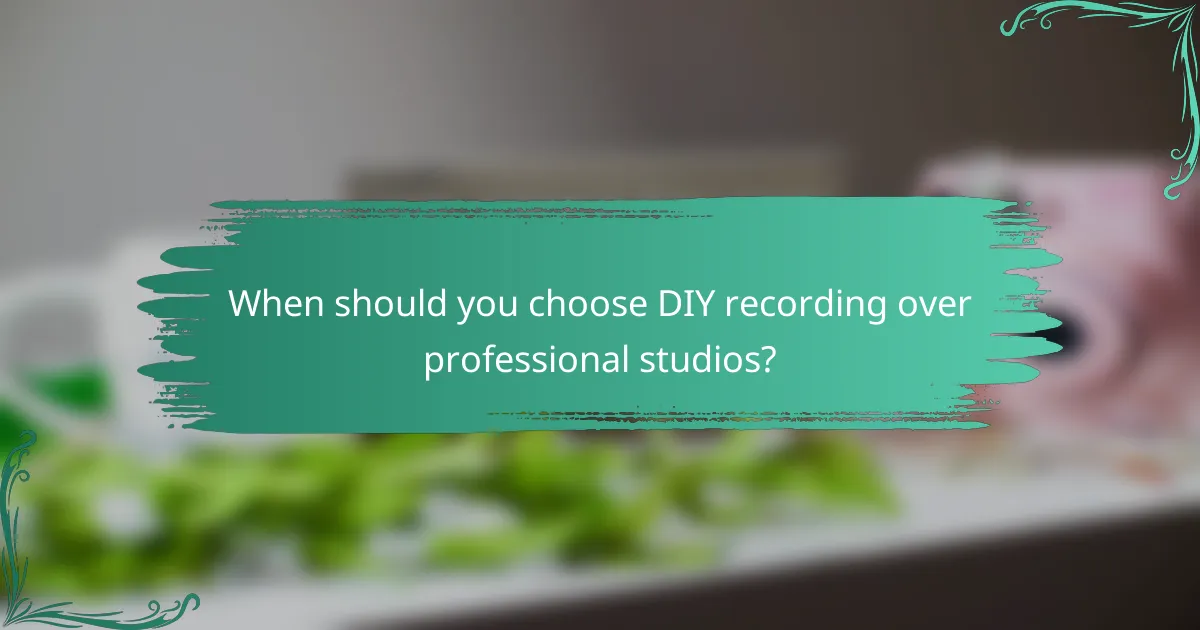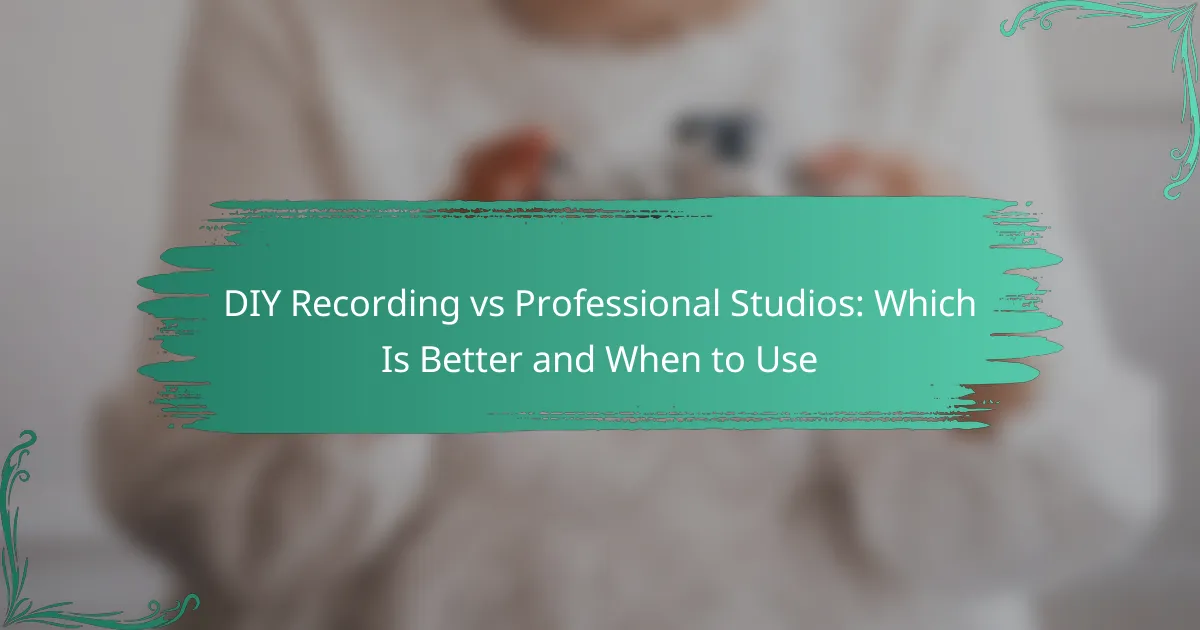Choosing between DIY recording and professional studios involves weighing factors like budget, project complexity, and desired sound quality. DIY recording is perfect for those seeking creative control and flexibility, while professional studios provide advanced technology and expertise for high-quality results. Understanding your specific needs will help you determine the best approach for your music project.

When should you choose DIY recording over professional studios?
DIY recording is ideal when budget constraints, scheduling flexibility, and a desire for creative control are top priorities. Independent artists often find that recording at home or in a personal space allows them to produce music that aligns closely with their vision without incurring high studio costs.
Cost-effectiveness for independent artists
DIY recording can significantly reduce expenses compared to professional studios, where hourly rates can range from $50 to several hundred dollars. By investing in basic recording equipment and software, artists can create high-quality tracks without the financial burden of studio fees.
Consider starting with a modest budget for essential gear, such as a good microphone, audio interface, and digital audio workstation (DAW). This initial investment can pay off quickly, especially for artists who plan to produce multiple projects over time.
Flexibility in recording schedule
One of the main advantages of DIY recording is the ability to work on your own schedule. Artists can record at any time, whether it’s late at night or early in the morning, without worrying about studio availability or time constraints.
This flexibility allows for experimentation and the opportunity to revisit tracks as inspiration strikes. Artists can take breaks as needed, which can lead to a more relaxed and productive recording environment.
Creative control during production
DIY recording empowers artists to maintain complete creative control over their music. They can experiment with different sounds, arrangements, and production techniques without the pressure of a ticking clock or external expectations.
This autonomy can lead to a more authentic sound that reflects the artist’s true vision. However, it’s essential to remain open to feedback and consider collaborating with others to enhance the final product when necessary.

What are the advantages of professional recording studios?
Professional recording studios offer superior sound quality and a range of specialized services that can significantly enhance the final product. They provide access to advanced technology, skilled personnel, and acoustically treated environments, making them ideal for high-stakes projects.
Access to high-quality equipment
Professional studios are equipped with top-tier recording gear, including high-end microphones, mixing consoles, and audio interfaces. This equipment is often beyond the reach of most DIY setups, ensuring that recordings capture the best possible sound quality.
For example, studios may use vintage microphones or state-of-the-art digital audio workstations that can cost thousands of dollars. This investment in equipment translates to clearer, more polished recordings that can stand out in a competitive market.
Expertise of sound engineers
Sound engineers in professional studios bring years of experience and technical knowledge to the recording process. Their expertise allows them to make critical decisions about sound mixing, mastering, and overall production quality.
Hiring a skilled engineer can save time and improve the final product, as they understand how to manipulate sound to achieve desired effects. This professional insight can be particularly beneficial for complex projects that require nuanced audio engineering.
Acoustic treatment and sound design
Professional studios are designed with acoustic treatment that minimizes unwanted noise and enhances sound clarity. This includes soundproofing, bass traps, and diffusers that create an optimal recording environment.
Effective sound design in these studios allows for greater control over the audio landscape, making it easier to achieve a specific sound or atmosphere. This is especially important for genres like classical or orchestral music, where subtle nuances can significantly impact the listening experience.

What factors influence the decision between DIY and professional studios?
The decision between DIY recording and using professional studios hinges on several key factors, including budget, project complexity, and the desired sound quality. Each factor plays a significant role in determining the most suitable option for your recording needs.
Budget constraints
Budget is often the primary consideration when choosing between DIY recording and professional studios. DIY setups can be cost-effective, with initial investments ranging from a few hundred to a couple of thousand dollars, depending on the equipment quality. In contrast, professional studios typically charge hourly rates that can vary widely, often from around $50 to several hundred dollars per hour.
When assessing your budget, consider not only the recording costs but also any additional expenses such as mixing, mastering, and potential travel to the studio. If funds are limited, a DIY approach may allow for more flexibility in managing costs while still achieving satisfactory results.
Project complexity
The complexity of your project significantly influences the choice between DIY and professional studios. Simple recordings, such as solo acoustic performances, may be effectively handled in a home studio with basic equipment. However, more intricate projects involving multiple instruments, layers, or advanced production techniques often benefit from the expertise and resources available in a professional setting.
Consider the specific requirements of your project. If it involves complex arrangements or high production values, a professional studio can provide the necessary tools and experienced engineers to ensure a polished final product. For straightforward projects, DIY may suffice.
Desired sound quality
Sound quality is a crucial factor in the decision-making process. Professional studios are equipped with high-end microphones, preamps, and acoustically treated rooms, which can significantly enhance the overall sound quality of your recordings. In contrast, DIY setups may struggle to achieve the same level of clarity and depth, especially in untreated spaces.
If achieving top-notch sound quality is paramount, investing in a professional studio is advisable. However, for projects where sound quality is less critical, such as demos or personal projects, a well-equipped DIY setup can still yield satisfactory results. Always assess the importance of sound quality relative to your project’s goals.

How does the recording environment affect sound quality?
The recording environment significantly impacts sound quality by influencing how sound waves interact with surfaces and materials. Factors such as room acoustics, equipment quality, and noise control play crucial roles in determining the clarity and fidelity of the final recording.
Impact of room acoustics
Room acoustics refer to how sound behaves in a space, including reflections, absorption, and diffusion. A well-designed room can enhance sound quality by minimizing unwanted echoes and reverberations. For example, a small, untreated room may produce muddier sound compared to a larger, acoustically treated space.
To improve room acoustics, consider using sound-absorbing materials like foam panels, carpets, or curtains. These can help reduce reflections and create a more controlled listening environment, which is essential for achieving professional-sounding recordings.
Equipment quality differences
The quality of recording equipment can vary widely between DIY setups and professional studios. Professional studios typically feature high-end microphones, preamps, and mixing consoles that capture sound with greater precision and detail. In contrast, DIY setups may rely on consumer-grade gear, which can limit sound quality.
When choosing equipment, prioritize investing in a good microphone and audio interface, as these components significantly influence the recording’s overall quality. Even a modestly priced setup can yield satisfactory results if the equipment is well-suited for the recording environment.
Noise control and isolation
Noise control and isolation are critical in maintaining sound quality by preventing external sounds from interfering with recordings. Professional studios often use soundproofing techniques to minimize outside noise, ensuring a clean recording environment. This can include double walls, specialized doors, and soundproof windows.
For DIY recording, consider using portable isolation booths or soundproofing materials to reduce noise intrusion. Simple solutions like recording during quieter times or using directional microphones can also help mitigate unwanted sounds, allowing for clearer recordings.

What are the typical costs associated with professional studios?
The costs associated with professional studios can vary widely based on location, equipment quality, and services offered. Generally, you can expect to pay anywhere from a few hundred to several thousand dollars for studio time, mixing, and mastering services.
Hourly rates for studio time
Hourly rates for studio time typically range from around $50 to $300, depending on the studio’s reputation and the equipment available. High-end studios in major cities may charge more, while smaller or less-known studios might offer lower rates to attract clients.
When booking studio time, consider the experience of the engineers and the quality of the equipment. It’s often worth investing in a reputable studio to ensure a professional sound.
Additional fees for mixing and mastering
In addition to hourly rates, professional studios often charge extra for mixing and mastering services. These fees can range from $100 to $1,000 or more, depending on the complexity of the project and the studio’s expertise.
Be sure to clarify what is included in the mixing and mastering fees. Some studios may offer package deals that bundle these services with studio time, which can be more cost-effective.
Package deals for extended sessions
Many professional studios offer package deals for extended sessions, which can provide significant savings. These packages might include a set number of hours for recording, mixing, and mastering at a reduced rate compared to hourly pricing.
When considering package deals, evaluate your project’s needs and timeline. If you anticipate needing several sessions, a package can be a smart financial choice. Always read the fine print to understand what services are included and any potential additional costs.

What are the essential tools for DIY recording?
Essential tools for DIY recording include an audio interface, microphones, and recording software. These components create a basic setup that allows you to capture high-quality audio at home.
Audio interface recommendations
An audio interface is crucial for converting analog signals from your instruments or microphones into digital audio. Popular options include the Focusrite Scarlett series and the PreSonus AudioBox, both of which offer good quality at reasonable prices, typically ranging from $100 to $200.
When choosing an audio interface, consider the number of inputs you need and the type of connectivity (USB, Thunderbolt) that works best with your computer. Look for interfaces with low latency to ensure real-time monitoring during recording.
Microphone types for home studios
Microphones come in various types, each suited for different recording scenarios. Dynamic microphones, like the Shure SM58, are durable and excellent for vocals and live performances, while condenser microphones, such as the Audio-Technica AT2020, are more sensitive and ideal for studio recordings.
For a home studio, it’s beneficial to have at least one of each type. Consider your recording environment; if you have a treated space, a condenser mic will capture more detail, while a dynamic mic can help reduce background noise.
Software options for recording and editing
Recording and editing software, known as Digital Audio Workstations (DAWs), are essential for DIY recording. Popular DAWs include Ableton Live, Logic Pro, and GarageBand, with prices ranging from free versions to several hundred dollars for professional editions.
When selecting a DAW, consider your workflow and the features you need, such as MIDI support or built-in effects. Many DAWs offer trial versions, allowing you to test them before committing to a purchase.
